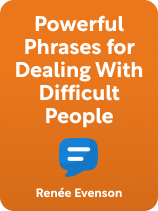

This article is an excerpt from the Shortform book guide to "Powerful Phrases for Dealing With Difficult People" by Renee Evenson. Shortform has the world's best summaries and analyses of books you should be reading.
Like this article? Sign up for a free trial here.
Do you avoid difficult conversations? What if you could get on the same page with others more easily?
Renée Evenson’s book Powerful Phrases for Dealing with Difficult People offers practical steps to establishing mutual empathy during conflict resolution. Her recommendations will help you navigate challenging discussions and find mutually beneficial solutions.
Keep reading to discover how to build empathetic connections and avoid defensive reactions.
Establishing Mutual Empathy
When you initiate conflict resolution, try to establish an empathetic connection as soon as possible. Evenson argues that, to have a productive discussion, you need to understand how the other person sees the conflict and get them to understand how you see it.
The key to this mutual empathy is to avoid making the other person feel defensive. If someone feels like you’re attacking, accusing, or blaming them, they’ll focus on protecting themselves by trying to “win” the fight. They’ll attack, accuse, and blame you instead of working toward a solution.
| Why People Make Others Defensive In The Anatomy of Peace, the Arbinger Institute agrees that mutual empathy is the cornerstone of conflict resolution, and they elaborate as to why so many people ignore this fact and adopt a combative mindset instead. After people do something that goes against someone else’s best interests, they often justify it by adopting beliefs about themselves and others that prove their hurtful actions were necessary. These beliefs then encourage them to attack, accuse, and blame others—which triggers similar defensive actions in return. For example, imagine a parent skips their child’s championship soccer game to finish a project at work. To justify this, they adopt the belief that their child should be mature enough to play without their validation. When their child asks why they weren’t watching the game, the parent says in a condescending tone, “You seriously need me to cheer for you at every game?” This causes their child to angrily accuse them of being negligent and unloving. |
We’re going to discuss a few ways to build empathetic connections and avoid triggering defensiveness: Focus on expressing your feelings, ask about the other person’s point of view, state your desire for compromise, and use constructive nonverbal signals.
Step 1: Begin by Stating Your Feelings
Evenson recommends beginning every conflict resolution with “I” messages: statements starting with “I” that express how the situation at hand impacted your feelings. For instance, “I felt offended when you minimized the importance of my team’s project at today’s meeting” and “I’m scared that customers will get upset if you use that kind of language in front of them” would be “I” messages. “I” messages allow you to bring up the problem without making it seem like you’re attacking, accusing, or blaming the other person.
In contrast, when most people start a confrontation, they instinctively resort to “you” messages: statements starting with “you” that frame the problem as the other person’s fault. For example, “You were being incredibly disrespectful in today’s meeting” and “You need to control yourself in front of the customers” would be “you” messages. “You” messages tend to make the other person defensive, escalating the conflict.
| Don’t Hide Accusations in Your “I” Messages Psychologist Thomas Gordon coined the term “I” messages in his 1970 book Parent Effectiveness Training. Other psychologists have since adopted this concept, sometimes referring to them as “I” statements or “I” phrases. Gordon’s official blog warns that “I” messages are ineffective when they contain hidden “you” messages. For example, if you say “I feel upset when you don’t think before making dumb decisions like this,” you’re essentially just saying, “You’re impulsive and make dumb decisions.” This statement conveys blame and shame, which will make the other person defensive. To avoid this, Gordon’s blog recommends making sure your “I” messages contain three key components: • An objective, non-accusatory description of the other person’s actions • A description of how you feel • A description of the consequences the other person’s actions have on your life For example, you might say, “I feel frustrated and overwhelmed (description of feelings) when you leave your dirty dishes in the sink (objective description of action) because it adds more work to my busy schedule (description of consequences).” |
Step 2: Ask About and Express the Other Person’s Point of View
After you express your feelings with an “I” message, ask objective, non-judgmental questions to encourage the other person to share their thoughts and feelings about the conflict. Evenson contends that when you seek to understand the other person’s perspective, you establish a tone of mutual respect and collaboration that will make it much easier to discover solutions.
While the other person explains how they see the situation, practice active listening: Use affirmative sounds like “ahh,” or “mhmm” to show that you understand what they’re saying. If you get confused at any point, use sounds like “hmm?” or “oh?” to let the other person know they need to clarify something.
(Shortform note: In How to Know a Person, David Brooks contends that the most effective form of active listening involves more than small sounds like “ahh” or “hmm?” He cites Oprah Winfrey as a master conversationalist because of her deeply involved listening habits. While listening, she intensely mirrors the speaker’s emotions with a wide range of facial expressions and nonverbal vocalizations, including gasps of surprise, somber looks of sympathy, and extended, almost musical hums of encouragement. Reactions like these demonstrate that the listener is deeply absorbed in the conversation, making the speaker feel heard and encouraging them to speak more.)
Furthermore, Evenson asserts that throughout your conversation, you should express the other person’s point of view. For example, you might say “I see how it would be frustrating to have me micromanaging your work like that,” or “You’ve probably felt pretty powerless since I took that project off your plate.” Ideally, this will prove to the other person that you want to find a solution that benefits them, and they’ll be more likely to cooperate. Verbally empathizing in this way can also inspire them to see the situation from your point of view.
| Persuade People by Using Empathetic Questions In How to Make Friends and Influence People, Dale Carnegie also recommends building empathy by asking questions and articulating the other person’s point of view in a disagreement. However, unlike Evenson, he contends that during this stage, you can also persuade them to change their mind. First, restate the other person’s point of view in a sympathetic way and assert that they’re justified in feeling the way they do. They’ll appreciate this concern and be more likely to listen to what you have to say. Next, ask obvious questions that force them to agree with you, to get them in an agreeable state of mind. Then, ask a series of questions that lead them through the logic of your perspective. Subtly highlight key pieces of information and reasoning that support your view, without explicitly stating your opinion, so they feel like they’re getting there on their own. By the end of the discussion, the other person will have talked themselves into your conclusion. For example, imagine your friend is considering quitting their job, but you believe that because they lack substantial savings, quitting without a backup plan might not be the best decision. Thus, you want to convince them not to quit. You start the conversation by saying, “I completely understand why you’re feeling so stressed and overwhelmed at work. I’d want to quit if I was in your position, too.” They agree, so you ask, “You want to minimize the amount of stress in your life right now, correct?” They say “yes” again, putting them in an agreeable mindset. Then, you start asking questions that subtly support your point of view: “Considering the current job market, do you think it might be challenging—and stressful—to find a new position that pays enough for you to cover your expenses?” They agree, so you ask, “Ideally, what would be the best way to transition from this job to a better one?” This question makes them realize that they should hunt for a new job before quitting outright. |
Step 3: Commit to Finding a Compromise
Evenson recommends directly stating throughout the conflict resolution process that you want to find a mutually acceptable compromise. This way, you repeatedly remind the other person that your goal is to negotiate in good faith rather than “win” the conflict by proving they’re in the wrong.
Anytime you need to defuse defensive reactions or refocus the dialogue on problem-solving, reaffirm your commitment to compromise. For example, you might say something like “Let’s talk this out and see if we can understand where each other is coming from,” or “I’m trying to find a solution that works for both of us.”
(Shortform note: In You Can Negotiate Anything, Herb Cohen argues the opposite: You should explicitly clarify that you’re not looking to compromise. If two people agree to look for a “compromise,” they enter the conversation expecting that they’ll have to sacrifice something they want. Consequently, they stop looking for creative solutions and may resort to win-lose negotiation tactics (like hiding how much they want something) to try and minimize their sacrifice. Instead, to focus your conversation, you may want to repeatedly clarify that you’re looking for a win-win solution, not a compromise.)
Step 4: Use Calm, Confident, and Empathetic Nonverbal Signals
Evenson explains that although the words you use are important, your body language, facial expressions, and tone of voice communicate your true feelings more directly. For this reason, send nonverbal signals that show the other person you’re calm, empathetic, and confident. Seeming calm and empathetic will keep the other person from getting defensive, and showing confidence will make them more likely to respect your desires and see your suggested solutions as valuable.
Evenson recommends using these nonverbal signals to have the most productive conflict resolution:
- Sit or stand upright to appear confident—but at the same time, stay loose and relaxed to appear calm.
- Maintain a kind, caring facial expression, even if you don’t feel kind or caring.
- Keep eye contact that’s strong, but not so strong that it makes the other person uncomfortable.
- Speak quietly and slowly rather than forcefully.
At first, you may feel like you’re awkwardly forcing yourself to perform these nonverbal signals, but over time, they’ll become instinctive and authentic.
| It’s Not Enough to Pretend to Feel Calm, Confident, and Empathetic In The Charisma Myth, Olivia Fox Cabane contends that if you want to project certain emotions in conversation, it’s not enough to focus on sending the right nonverbal signals. People are incredibly good at perceiving your true emotions, especially those that you communicate through body language. There are too many parts of your body moving and reacting all the time for you to convincingly control them all perfectly—and if your demeanor contradicts the way you claim to feel, others will detect it. Instead, Cabane insists that the most effective way to project the feelings you want others to perceive is to actually feel them. If these emotions are real to you, they’ll be real to others because they’ll naturally manifest in your nonverbal cues. Cabane recommends strategies like reframing negative thoughts and practicing mindfulness to evoke these desired emotions. That said, Cabane also recommends practicing nonverbal habits in conjunction with these internal strategies. Cabane would likely agree with Evenson’s specific tips, as they comprise what Cabane says are two of the basic components of charisma: authority and warmth. Upright posture and slow, quiet speech help project authority, which makes others think you have the power to help them. A caring facial expression and eye contact help project warmth, which makes others think you’d want to help them. |

———End of Preview———
Like what you just read? Read the rest of the world's best book summary and analysis of Renee Evenson's "Powerful Phrases for Dealing With Difficult People" at Shortform.
Here's what you'll find in our full Powerful Phrases for Dealing With Difficult People summary:
- The downsides of avoiding conflict
- How to keep people from getting defensive
- What to do before you attempt conflict resolution






